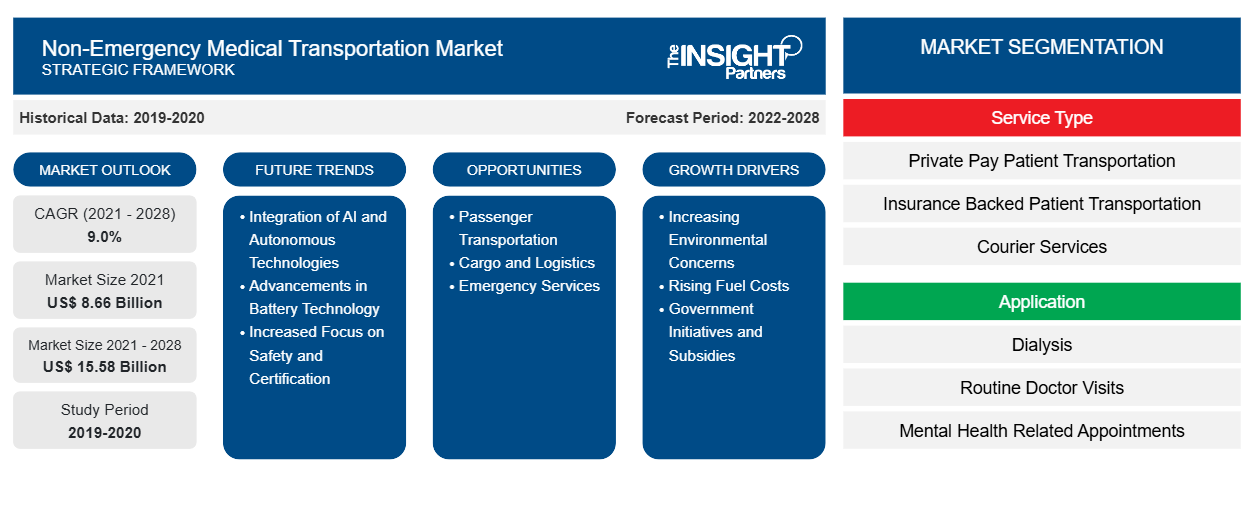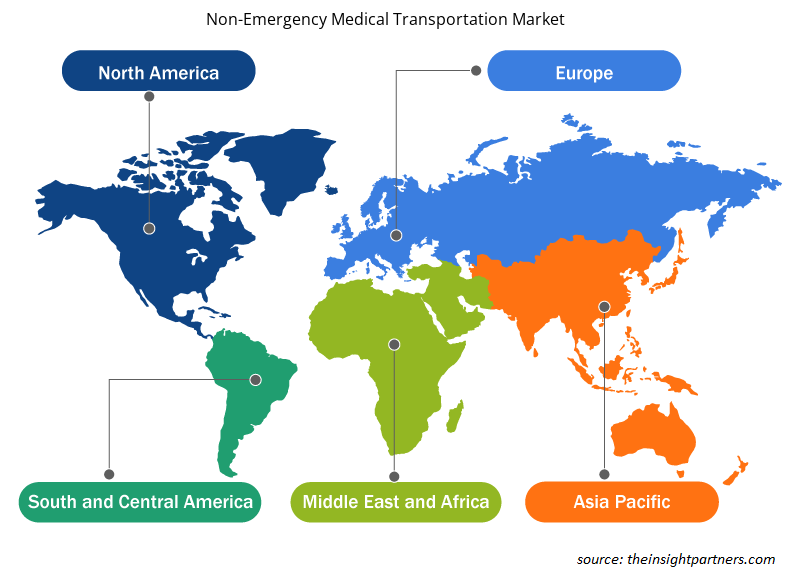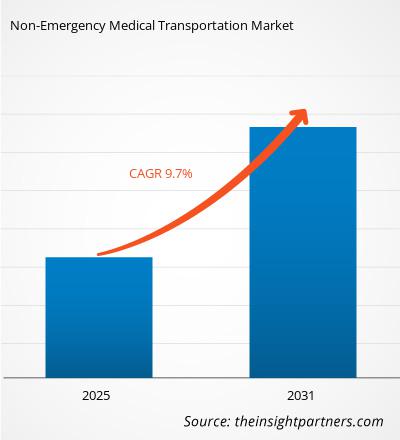Si prevede che il mercato del trasporto medico non di emergenza raggiungerà i 31.872,49 milioni di dollari entro il 2031, rispetto ai 16.714,80 milioni di dollari del 2024. Si prevede che il mercato registrerà un CAGR del 9,7% nel periodo 2025-2031. I progressi tecnologici nel trasporto medico non di emergenza probabilmente introdurranno nuove tendenze nel mercato nei prossimi anni.
Analisi del mercato del trasporto medico non di emergenza
I fattori che guidano il mercato del trasporto medico non di emergenza includono la crescente necessità di trasporto medico non di emergenza e l'aumento dell'incidenza di patologie croniche nella popolazione anziana. Inoltre, si prevede che gli sviluppi tecnologici nel campo del trasporto medico non di emergenza contribuiranno alla crescita del mercato. Si prevede che le iniziative strategiche degli operatori del mercato creeranno ampie opportunità nei prossimi anni.
Panoramica del mercato del trasporto medico non di emergenza
Si prevede che il Nord America dominerà il mercato del trasporto medico non di emergenza, e si prevede che l'Asia-Pacifico registrerà un tasso di crescita significativo a causa della crescente prevalenza di malattie croniche tra gli anziani e della crescente domanda di soluzioni sanitarie migliorate. L'aumento della spesa sanitaria e lo sviluppo delle infrastrutture sanitarie, insieme al crescente turismo medico, hanno anche aumentato la domanda di trasporto medico non di emergenza nelle regioni. Nell'area APAC , la Cina rappresenta la quota di mercato maggiore e l'India registra un tasso di crescita significativo nella regione. La Cina prevede di investire 1,5 trilioni di dollari nei prossimi anni per promuovere ulteriormente l'innovazione tecnologica in ambito sanitario. Oltre al piano Healthy China 2030, questa spesa è destinata a garantire l'equità sanitaria in Cina attraverso progressi tecnologici e miglioramenti del sistema sanitario. Secondo un rapporto del Ministero degli Affari Civili e del Comitato Nazionale Cinese sull'Invecchiamento , la Cina ha una delle popolazioni anziane più numerose al mondo. Nel 2023, la popolazione cinese di età pari o superiore a 60 anni era di oltre 297 milioni, pari al 21,1% della popolazione totale. La popolazione geriatrica cinese si trova ad affrontare un peso crescente dovuto alle malattie croniche , con l'età avanzata come principale fattore di rischio che contribuisce all'insorgenza delle malattie. Secondo lo studio "Unmet Needs for Chronic Diseases in China", pubblicato sul BMJ Journal nel 2024, le malattie non trasmissibili ( NCD ) rappresentano la minaccia sanitaria più significativa nel Paese, essendo responsabili del 91% di tutti i decessi. Le principali NCD in Cina includono malattie cardiovascolari (43%), tumori (23%) e diabete mellito (2%).
Personalizza questo report in base alle tue esigenze
Riceverai la personalizzazione gratuita di qualsiasi report, incluse parti di questo report, analisi a livello nazionale, pacchetto dati Excel e potrai usufruire di fantastiche offerte e sconti per start-up e università.
Mercato del trasporto medico non di emergenza: approfondimenti strategici

-
Scopri le principali tendenze di mercato di questo rapporto.Questo campione GRATUITO includerà analisi di dati che spaziano dalle tendenze di mercato alle stime e alle previsioni.
Driver e opportunità del mercato del trasporto medico non di emergenza
Crescente domanda di trasporto medico non urgente
Secondo l'American Hospital Association, ogni anno circa 3,6 milioni di persone negli Stati Uniti non ricevono le cure mediche necessarie a causa di problemi di trasporto (mancanza di accesso ai veicoli, lunghe distanze dalle strutture sanitarie, infrastrutture di trasporto pubblico inadeguate e costi elevati). Uno studio di UC Davis Health ha rivelato che circa 5,8 milioni di americani ogni anno perdono o ritardano le cure mediche a causa di ostacoli ai trasporti. Il trasporto è un fattore significativo che contribuisce alla perdita di appuntamenti medici. Un'indagine del 2019 condotta da Kaiser Permanente ha rilevato che un terzo degli americani soffre frequentemente o occasionalmente di stress dovuto ai trasporti.
Dal 1965, Medicaid offre un servizio di trasporto medico non di emergenza ( NEMT ), e alle persone coperte da Medicaid vengono forniti servizi di trasporto come prestazione essenziale. Secondo il Medicaid Enrollment and Unwinding Tracker, circa 94 milioni di persone in totale erano iscritte a Medicaid fino ad aprile 2023. Il KFF Medicaid Budget Survey ha previsto un aumento dell'8,2% degli iscritti all'assistenza sanitaria nel 2021 negli Stati Uniti, principalmente a causa della crisi COVID-19 e dell'elevato tasso di disoccupazione. Con l'aumento dell'accesso a Medicaid, si registra un aumento diretto della domanda di servizi NEMT .
La maggior parte degli stati degli Stati Uniti è passata all'erogazione di NEMT tramite broker NEMT o organizzazioni di assistenza gestita (MCO). In molti stati, i broker o le MCO ricevono un compenso pro capite per la supervisione dei servizi NEMT, mentre altri stati, tra cui Nevada, Arizona e Vermont, erogano NEMT a pagamento tramite fornitori di servizi locali. Il Children's Health Insurance Program (CHIP) offre copertura sanitaria ai bambini idonei tramite Medicaid e programmi CHIP separati. Il CHIP è amministrato dagli stati in conformità con i requisiti federali e finanziato congiuntamente dai governi statali e federali. Pertanto, con l'aumento di tali iniziative da parte dei governi, la domanda di NEMT è in aumento, stimolando così la crescita del mercato.
Le iniziative strategiche di NEMT e delle aziende di reti di trasporto creano ampie opportunità di crescita del mercato
Le aziende NEMT e le aziende di reti di trasporto (TNC) sono ansiose di intraprendere azioni strategiche per migliorare l'accesso alle cure. Le TNC, come Uber o Lyft, sono note per le loro funzionalità di ride-hailing on-demand e per le app mobili intuitive. Queste funzionalità possono risolvere efficacemente i problemi di disponibilità e programmazione relativi ai servizi NEMT. Diverse TNC stanno attualmente sviluppando nuove piattaforme o sono impegnate in collaborazioni con NEMT e singoli fornitori di servizi sanitari in tutto il mondo. Diverse agenzie statali stanno consentendo l'utilizzo delle TNC per fornire servizi NEMT. Di seguito sono riportati alcuni esempi.
- Nel giugno 2024, Uber ha ufficialmente introdotto Uber Health, una piattaforma volta ad aiutare i pazienti a raggiungere i loro appuntamenti medici, riducendo così le assenze e migliorando la puntualità. Questa iniziativa è conforme alla normativa HIPAA e offre un'alternativa economica ai tradizionali servizi di taxi, a vantaggio soprattutto delle organizzazioni sanitarie più piccole prive di risorse di trasporto dedicate. Con una copertura in oltre 250 città degli Stati Uniti, la piattaforma di Uber incentrata sull'assistenza sanitaria amplia significativamente l'accesso al NEMT.
- Nel gennaio 2024, MediDrive, azienda partner di CTG, è entrata formalmente nel mercato NEMT. L'azienda si dedica ad affrontare le complessità del trasporto dei pazienti da e per gli appuntamenti e le procedure sanitarie.
- A giugno 2022, MTM ha lanciato il programma Elevate per offrire una gestione proattiva dei viaggi. MTM adotta un approccio proattivo alla gestione dei viaggi per i propri iscritti al programma Elevate, offrendo un servizio di livello concierge per viaggi complessi e rispondendo alle specifiche esigenze di trasporto dei propri iscritti.
- Nel febbraio 2022, Modivcare Inc. ha lanciato Modivcare Academy. Questa iniziativa innovativa mira ad assistere i fornitori di servizi di trasporto nel NEMT (New Mexico) offrendo risorse formative, opportunità di networking e formazione. Il programma fornisce in modo esclusivo ai fornitori di servizi di trasporto strumenti aziendali essenziali, best practice e formazione per supportare efficacemente l'assistenza alle popolazioni più vulnerabili del Paese.
Tali iniziative strategiche si concentrano sul miglioramento dell'efficienza dei servizi, sull'aumento dell'accessibilità per i pazienti, sulla riduzione dei costi operativi e sulla garanzia di una migliore integrazione con i servizi sanitari. Con la continua crescita del settore NEMT, queste iniziative saranno cruciali per espandere i servizi e migliorare la qualità dell'assistenza ai pazienti in tutto il mondo.
Analisi della segmentazione del rapporto di mercato sul trasporto medico non di emergenza
I segmenti chiave che hanno contribuito alla derivazione dell'analisi di mercato del trasporto medico non di emergenza sono il tipo di servizio, la struttura, l'applicazione e l'utente finale.
- In base alla tipologia di servizio, il mercato del trasporto medico non di emergenza è segmentato in trasporto privato di pazienti a pagamento, trasporto assicurato di pazienti, servizi di corriere e altri. Il segmento del trasporto privato di pazienti a pagamento ha detenuto la quota di mercato maggiore nel 2024 e si prevede che registrerà il CAGR più elevato nel periodo 2024-2031.
- Per struttura, il mercato del trasporto medico non di emergenza si divide in intra-struttura e inter-struttura. Il segmento inter-struttura ha detenuto una quota di mercato maggiore nel 2024 e si prevede che registrerà un CAGR più elevato nel periodo 2024-2031.
- Per applicazione, il mercato del trasporto medico non di emergenza è segmentato in dialisi, visite mediche di routine, visite per la salute mentale, riabilitazione e altri servizi. Il segmento delle visite per la salute mentale ha detenuto la quota di mercato maggiore nel 2024; si prevede che il segmento della riabilitazione registrerà il CAGR più elevato nel periodo 2024-2031.
- In termini di utenti finali, il mercato del trasporto medico non di emergenza è segmentato in ospedali e cliniche, case di cura, strutture di assistenza domiciliare, MCO e agenzie statali, enti pagatori dell'assistenza sanitaria e altri. Il segmento ospedali e cliniche ha dominato il mercato nel 2024 e si prevede che il segmento delle case di cura registrerà il CAGR più elevato nel periodo 2024-2031.
Analisi della quota di mercato del trasporto medico non di emergenza per area geografica
L'ambito geografico del rapporto sul mercato del trasporto medico non di emergenza è suddiviso principalmente in cinque regioni: Nord America, Asia Pacifico, Europa, Medio Oriente e Africa e Sud e Centro America.
Il Nord America deteneva una quota significativa del mercato nel 2023. La crescita del mercato del trasporto medico non di emergenza è attribuibile alla crescente prevalenza di varie malattie, all'espansione della copertura assicurativa per il trasporto medico non di emergenza (NEMT) e a un elevato tasso di rimborso statale per questi servizi come spese amministrative o mediche. Inoltre, un passaggio a un'assistenza incentrata sul paziente, una maggiore consapevolezza del NEMT e i progressi tecnologici sono tra gli altri fattori che sostengono la crescita del mercato. Malattie croniche, età avanzata, disabilità, infortuni e obesità sono solo alcune delle numerose ragioni per cui gli americani si affidano ai servizi di trasporto medico non di emergenza. La pandemia ha generato un'enorme necessità di un trasporto affidabile in auto per raggiungere appuntamenti, visite mediche essenziali e trattamenti quotidiani. Inoltre, l'aumento del numero di anziani sta contribuendo alla crescita del mercato del trasporto medico non di emergenza nel Paese. Le aziende che operano nel mercato stanno adottando strategie di sviluppo organiche e inorganiche per l'espansione del mercato. Di seguito sono riportati alcuni esempi:
- Coastal Medical Transportation Systems (CMTS), un'azienda privata di trasporto medico con sede nel Massachusetts, ha acquisito la divisione di trasporto medico di Transformative Healthcare nel settembre 2022. Questa divisione comprendeva LifeLine Ambulance Service e Fallon Ambulance Service. Grazie a questa acquisizione, CMTS è diventata una delle più grandi reti di ambulanze dello stato, sia in termini di numero di pazienti serviti che di area geografica coperta.
- Nel settembre 2022, il Baystate Wing Hospital ha collaborato con Quaboag Connector per fornire servizi di trasporto per l'assistenza sanitaria in Massachusetts. Questo servizio "curb-to-curb" offre NEMT (Neo-Neo-Meditation Service), consentendo ai pazienti di richiedere un passaggio da e per gli appuntamenti medici presso le strutture del Baystate Wing Hospital.
Approfondimenti regionali sul mercato del trasporto medico non di emergenza
Le tendenze e i fattori regionali che influenzano il mercato del trasporto medico non di emergenza durante il periodo di previsione sono stati ampiamente illustrati dagli analisti di Insight Partners. Questa sezione illustra anche i segmenti e la distribuzione geografica del mercato del trasporto medico non di emergenza in Nord America, Europa, Asia-Pacifico, Medio Oriente e Africa, e America Meridionale e Centrale.

- Ottieni i dati specifici regionali per il mercato del trasporto medico non di emergenza
Ambito del rapporto di mercato sul trasporto medico non di emergenza
| Attributo del report | Dettagli |
|---|---|
| Dimensioni del mercato nel 2024 | 16.714,80 milioni di dollari USA |
| Dimensioni del mercato entro il 2031 | 31.872,49 milioni di dollari USA |
| CAGR globale (2025-2031) | 9,7% |
| Dati storici | 2021-2023 |
| Periodo di previsione | 2025-2031 |
| Segmenti coperti |
Per tipo di servizio
|
| Regioni e paesi coperti |
America del Nord
|
| Leader di mercato e profili aziendali chiave |
|
Densità degli operatori del mercato del trasporto medico non di emergenza: comprendere il suo impatto sulle dinamiche aziendali
Il mercato del trasporto medico non di emergenza è in rapida crescita, trainato dalla crescente domanda degli utenti finali, dovuta a fattori quali l'evoluzione delle preferenze dei consumatori, i progressi tecnologici e una maggiore consapevolezza dei vantaggi del prodotto. Con l'aumento della domanda, le aziende stanno ampliando la propria offerta, innovando per soddisfare le esigenze dei consumatori e sfruttando le tendenze emergenti, alimentando ulteriormente la crescita del mercato.
La densità degli operatori di mercato si riferisce alla distribuzione delle imprese che operano in un determinato mercato o settore. Indica quanti concorrenti (operatori di mercato) sono presenti in un determinato spazio di mercato in relazione alle sue dimensioni o al suo valore totale.
Le principali aziende che operano nel mercato del trasporto medico non di emergenza sono:
- MTM, Inc.
- Resistenza antimicrobica
- Trasporto espresso
- CJ Medical Transportation
- VERIDA
Disclaimer : le aziende elencate sopra non sono classificate secondo alcun ordine particolare.

- Ottieni una panoramica dei principali attori del mercato del trasporto medico non di emergenza
Notizie e sviluppi recenti sul mercato del trasporto medico non di emergenza
Il mercato del trasporto medico non di emergenza viene valutato raccogliendo dati qualitativi e quantitativi a seguito di ricerche primarie e secondarie, che includono importanti pubblicazioni aziendali, dati di associazioni e database. Di seguito sono elencati alcuni degli sviluppi nel mercato del trasporto medico non di emergenza:
- Modivcare Inc. ha lanciato il suo Integration Hub, una piattaforma digitale rivoluzionaria che rivoluziona il coinvolgimento e l'esperienza degli iscritti a Medicaid e Medicare con benefit NEMT. L'Integration Hub di Modivcare è una novità assoluta nel settore, che offre una piattaforma di mobilità modulare ed estensibile che espone API (Application Programming Interface) aperte ai suoi clienti di piani sanitari commerciali, alle agenzie Medicaid statali e ai partner delle strutture. (Fonte: ModivCare, sito web aziendale, maggio 2024)
- MTM, il più grande broker NEMT privato degli Stati Uniti, ha firmato un accordo con Global Medical Response per l'acquisizione di Access2Care, LLC. Questa acquisizione strategica ha migliorato significativamente la presenza di MTM sul mercato e aumentato il fatturato annuo totale, segnando una pietra miliare nel percorso di crescita dell'azienda. L'acquisizione del business NEMT di Access2Care è frutto di un'attenta valutazione ed è in linea con le iniziative di espansione strategica di MTM. (Fonte: MTM, Inc, sito web aziendale, agosto 2024)
- Acadian Ambulance Service ha annunciato la stipula di un accordo per l'acquisizione sostanziale di tutti gli asset di SouthernCross Ambulance, un fornitore di servizi di emergenza medica con sede a New Braunfels, in Texas. Questa acquisizione consente ad Acadian di gestire 12 ambulanze aggiuntive e 10 furgoni per sedie a rotelle aggiuntivi e di assumere nuovo personale. SouthernCross Ambulance offre servizi di trasporto in ambulanza, sia per emergenze che per emergenze, nelle aree del Centro-Sud e del Sud del Texas, fornendo trasporti locali e a lunga distanza da e per ospedali, centri di riabilitazione, cliniche, case di cura e centri di assistenza infermieristica specializzata. (Fonte: Acadian Ambulance Service, sito web aziendale, gennaio 2024)
Copertura e risultati del rapporto sul mercato del trasporto medico non di emergenza
Il rapporto "Dimensioni e previsioni del mercato del trasporto medico non di emergenza (2021-2031)" fornisce un'analisi dettagliata del mercato che copre le seguenti aree:
- Dimensioni e previsioni del mercato del trasporto medico non di emergenza a livello globale, regionale e nazionale per tutti i principali segmenti di mercato coperti dall'ambito
- Tendenze del mercato del trasporto medico non di emergenza e dinamiche di mercato come conducenti, sistemi di ritenuta e opportunità chiave
- Analisi PEST e SWOT dettagliate
- Analisi del mercato del trasporto medico non di emergenza che copre le principali tendenze del mercato, il quadro globale e regionale, i principali attori, le normative e i recenti sviluppi del mercato
- Analisi del panorama industriale e della concorrenza che copre la concentrazione del mercato, l'analisi della mappa di calore, i principali attori e gli sviluppi recenti per il mercato del trasporto medico non di emergenza
- Profili aziendali dettagliati
- Analisi storica (2 anni), anno base, previsione (7 anni) con CAGR
- Analisi PEST e SWOT
- Valore/volume delle dimensioni del mercato - Globale, Regionale, Nazionale
- Industria e panorama competitivo
- Set di dati Excel
Report recenti
Rapporti correlati
Testimonianze
Motivo dell'acquisto
- Processo decisionale informato
- Comprensione delle dinamiche di mercato
- Analisi competitiva
- Analisi dei clienti
- Previsioni di mercato
- Mitigazione del rischio
- Pianificazione strategica
- Giustificazione degli investimenti
- Identificazione dei mercati emergenti
- Miglioramento delle strategie di marketing
- Aumento dell'efficienza operativa
- Allineamento alle tendenze normative






















 Ottieni un campione gratuito per - Mercato del trasporto medico non di emergenza
Ottieni un campione gratuito per - Mercato del trasporto medico non di emergenza